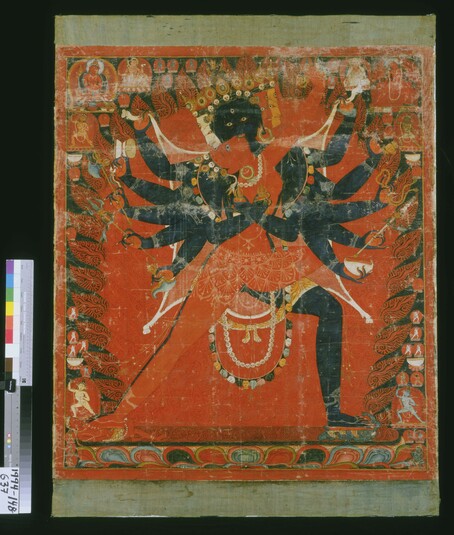
Item: Chakrasamvara (Buddhist Deity)
| Origin Location | Tibet |
|---|---|
| Date Range | 1400 - 1499 |
| Lineages | Sakya and Buddhist |
| Size | 121.92x106.68cm (48x42in) |
| Material | Ground Mineral Pigment on Cotton |
| Collection | Philadelphia Museum of Art |
| Catalogue # | acc. #1994-148-637, Stella Kramrisch Collection, 1994 |
Classification: Deity
Chakrasamvara according to the System of Krishnacharin accompanied by the four principal attendant Dakinis and the remainder of the sixty-two deities from the mandala.
Video: Chakrasamvara HAR #87008
Tibetan: Khor lo dem chog
Chakrasamvara has four faces and twelve arms, blue in colour, and standing on two legs. He embraces with the first pair of arms the female consort Vajrayogini. She has one face and two hands, red in colour, and wraps both legs around the male figure.
"...Shri Cakrasamvara with a body blue in colour, four faces and twelve hands. The main face is blue, left face red, back face yellow and right face white. Each face has three eyes and four bared fangs. The first two hands hold a vajra and bell embracing the mother. The lower two hold an elephant skin out-stretched; third right a damaru, fourth an axe, fifth a trident, sixth a curved knife. The third left holds a katvanga marked with a vajra; fourth a vajra lasso, fifth a blood filled skullcup, sixth carries the four-faced head of Brahma. The right leg is straight and presses on the breast of red Kalaratri; left bent and pressing on the head of black Yama. The hair is tied in a topknot on the crown of the head; on the crest a wish-fulfilling jewel ornament and crescent moon. The soft spot at the top of the head is marked with a vishva-vajra. Each head has a crown of five dry human skulls; a necklace of fifty fresh heads and six bone ornaments; wearing a lower garment of tiger skin; possessed of the nine emotions of dancing; grace, fearlessness and ugliness; laughter, ferocity and frightfulness; compassion, fury and peacefulness. In the lap is the Mother Vajravarahi, with a body red in colour, one face, two hands and three eyes. The left holds a blood filled skullcup embracing the Father and the right a curved knife in a threatening gesture pointed in all directions. The hair is worn piled on the head; a crown of five dry human skulls and fifty dry as a necklace. The left leg is straight and right bent, embracing the Father. Both Father-Mother stand in the middle of a blazing fire of pristine awareness." (Jamyang Kyentse Wangpo).
At the four corners surrounding Chakrasamvara are the four principal retinue figures called 'Dakinis.' Each figure has one face and two arms, a unique colour, standing with the right leg bent and the left leg straight: red Khandaroha, green Lama, yellow Rupini, blue Dakini.
At the top left corner is Vajradharma, red in colour, holding a vajra and bell. To the right ios the mahasiddha Krishnacharin. At the top right corner is Naro Khechari Vajrayogini according to the system of Naropa. At the left is Sachen Kunga Nyingpo.
Eight groups of figures with four deity couples per group are scattered about the composition. These deities are the remainder of the retinue figures that inhabit the Sixty-two deity Mandala of Chakrasamvara. At the bottom right corner of the composition is the protector deity Panjarnata Mahakala.
Jeff Watt 7-2009
Buddhist Deity: Chakrasamvara (Four Faces)
Buddhist Deity: Chakrasamvara Main Page
Collection of Philadelphia Museum of Art: Nepal (Painting Masterworks)
Buddhist Deity: Chakrasamvara (Masterworks, Painting)
Collection of Philadelphia Museum of Art (Sakya Masterpieces)
Collection of Philadelphia Museum of Art: Nepalese Painting
Collection of Philadelphia Museum of Art (Masterworks)
Collection of Philadelphia Museum of Art: Sakya Tradition
Buddhist Deity: Chakrasamvara (Early Figurative Painting)
Collection of Philadelphia Museum of Art
